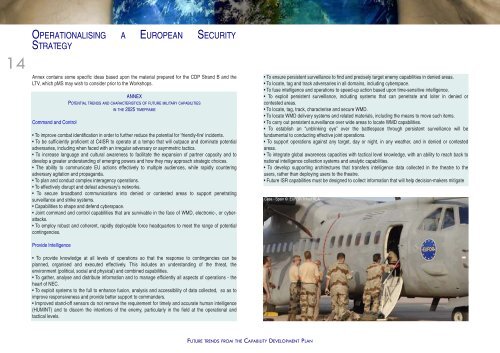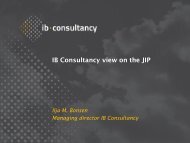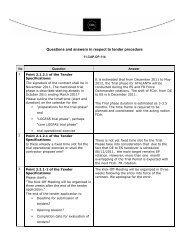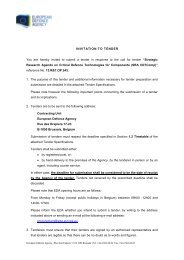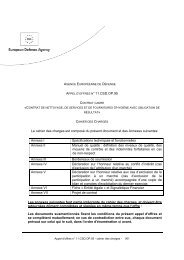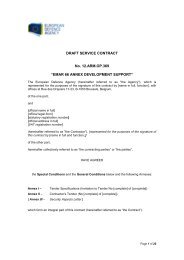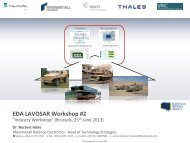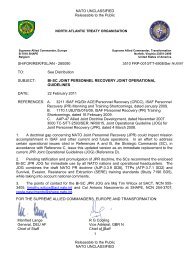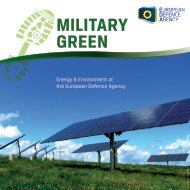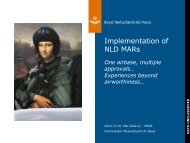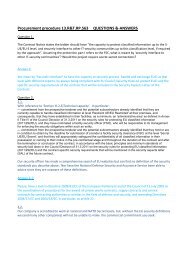capability development plan - European Defence Agency - Europa
capability development plan - European Defence Agency - Europa
capability development plan - European Defence Agency - Europa
Create successful ePaper yourself
Turn your PDF publications into a flip-book with our unique Google optimized e-Paper software.
14<br />
OPERATIONALISING A EUROPEAN SECURITY<br />
STRATEGY<br />
Annex contains some specific ideas based upon the material prepared for the CDP Strand B and the<br />
LTV, which pMS may wish to consider prior to the Workshops.<br />
Command and Control<br />
ANNEX<br />
POTENTIAL TRENDS AND CHARACTERISTICS OF FUTURE MILITARY CAPABILITIES<br />
IN THE 2025 TIMEFRAME<br />
• To improve combat identification in order to further reduce the potential for ‘friendly-fire’ incidents.<br />
• To be sufficiently proficient at C4ISR to operate at a tempo that will outpace and dominate potential<br />
adversaries, including when faced with an irregular adversary or asymmetric tactics.<br />
• To increase language and cultural awareness to facilitate the expansion of partner capacity and to<br />
develop a greater understanding of emerging powers and how they may approach strategic choices.<br />
• The ability to communicate EU actions effectively to multiple audiences, while rapidly countering<br />
adversary agitation and propaganda.<br />
• To <strong>plan</strong> and conduct complex interagency operations.<br />
• To effectively disrupt and defeat adversary’s networks.<br />
• To secure broadband communications into denied or contested areas to support penetrating<br />
surveillance and strike systems.<br />
• Capabilities to shape and defend cyberspace.<br />
• Joint command and control capabilities that are survivable in the face of WMD, electronic-, or cyberattacks.<br />
• To employ robust and coherent, rapidly deployable force headquarters to meet the range of potential<br />
contingencies.<br />
Provide Intelligence<br />
• To provide knowledge at all levels of operations so that the response to contingencies can be<br />
<strong>plan</strong>ned, organised and executed effectively. This includes an understanding of the threat, the<br />
environment (political, social and physical) and combined capabilities.<br />
• To gather, analyse and distribute information and to manage efficiently all aspects of operations - the<br />
heart of NEC.<br />
• To exploit systems to the full to enhance fusion, analysis and accessibility of data collected, so as to<br />
improve responsiveness and provide better support to commanders.<br />
• Improved stand-off sensors do not remove the requirement for timely and accurate human intelligence<br />
(HUMINT) and to discern the intentions of the enemy, particularly in the field at the operational and<br />
tactical levels.<br />
• To ensure persistent surveillance to find and precisely target enemy capabilities in denied areas.<br />
• To locate, tag and track adversaries in all domains, including cyberspace.<br />
• To fuse intelligence and operations to speed-up action based upon time-sensitive intelligence.<br />
• To exploit persistent surveillance, including systems that can penetrate and loiter in denied or<br />
contested areas.<br />
• To locate, tag, track, characterise and secure WMD.<br />
• To locate WMD delivery systems and related materials, including the means to move such items.<br />
• To carry out persistent surveillance over wide areas to locate WMD capabilities.<br />
• To establish an “unblinking eye” over the battlespace through persistent surveillance will be<br />
fundamental to conducting effective joint operations.<br />
• To support operations against any target, day or night, in any weather, and in denied or contested<br />
areas.<br />
• To integrate global awareness capacities with tactical level knowledge, with an ability to reach back to<br />
national intelligence collection systems and analytic capabilities.<br />
• To develop supporting architectures that transfers intelligence data collected in the theatre to the<br />
users, rather than deploying users to the theatre.<br />
• Future ISR capabilities must be designed to collect information that will help decision-makers mitigate<br />
Casa - Spain © EUFOR Tchad RCA<br />
FUTURE TRENDS FROM THE CAPABILITY DEVELOPMENT PLAN


